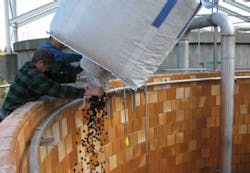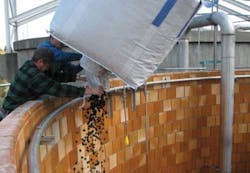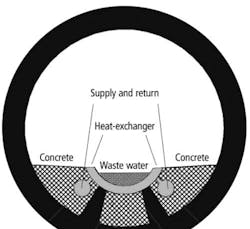Sludge Pretreatment System Holds Promise for Increased Biogas Production
By Harry Simmon
The promise of benefits from pretreatment systems that break up cell structures in sludge has been accepted since the 1970s. Yet 30 years later, no pretreatment technologies are in wide spread use in North America. Considering the increasing pressure today for energy efficiency and for sustainable biosolids disposal, these benefits are more valuable now than ever before.
Today the only pretreatment systems currently operating permanently in North America at full scale are the OpenCEL systems at the Northwest Water Reclamation Facility in Mesa, AZ, and at the Racine Wastewater Treatment Plant in Wisconsin. The Mesa unit has been in operation since April 2007 at the plant, where flows are 8-10 mgd. Not only is the system treating sludge for digestion, but also a fraction of the treated material is piped to the two pre-anoxic zones of the BNR trains as a substitute for methanol to drive denitrification.
The Racine plant treats an average of 20 mgd. The pretreatment system there was to begin operation in early 2012. Unlike the Mesa unit, which treats a combination of thickened primary and waste activated sludge, the installation at Racine was designed to treat only the secondary sludge flow.
When Mesa pretreats 95% of its sludge, biogas production increases 55-60% and biosolids for dewatering and disposal are cut over 30%. These percentages derive from data collected over four years at the plant.
Sludge as Carbon Source
Before the pretreatment system went to work, the Mesa facility used methanol as a supplemental carbon source for denitrification. Today, a fraction of the output of the pretreatment system at Mesa is diverted from the digester to the BNR process through the use of a secondary holding tank and delivery system. Of the 50,000 gpd of 5% sludge treated, about 10% gets sent to denitrification. While lost to digestion and therefore not contributing to biogas production, the treated sludge is worth 10 times more as a methanol substitute than as biogas.
Cell Lysis Research
While the use of sludge as a carbon source, without fermentation, was a surprise, the improvements in digestion were predicted 30 years ago.
In the late 1970s, Professor Perry McCarty at Stanford University was looking for a way to improve anaerobic digestion. He knew that Primary Sludge (PS) is easily digested and Waste Activated Sludge (WAS) is not. Indeed, about two thirds of WAS passes through the digester untreated. The reason is that most of the material in WAS is cellular, and most PS is not. The cell walls protect the cell contents so well, most of the cellular material is unavailable to the anaerobic microbes in the digester and passes through the process.
Professor McCarty looked for ways to overcome the defenses of the cell. When the cell wall is violated, the event is said to be "cell lysis". McCarty found he could lyse cells in the lab by cooking them. When he fed cooked WAS to his lab scale digester he found that the volatile solids reduction (VSR) rate increased by two to three times. He saw biogas production almost double, and solids exiting digestion fall by half.
Attempts to commercialize this discovery were disappointing. Lysis can be achieved at high temperature (as in the original Stanford research), at high pH or low pH, by extreme oxidation, at high pressure or partial vacuum, as examples. Yet the products that employed the technologies to achieve these extremes either cost more to own than the value of the benefits they provided, or the results were a fraction of what McCarty found were obtainable.
Ultrasonics, cavitation, pasteurization, electrolysis, oxidation and other technologies never took hold. Many were power hogs. Many were thought to only break up flocs, achieving 10-20% improvements at best, but not the 50% or more the Stanford lab data predicted.
Focused Pulse Treatment
Also about 30 years ago, at Ohio State University, food scientists were looking for a way to purify food without subjecting it to the high temperatures associated with pasteurization, a process it was believed degraded flavor. To kill pathogens in food they developed what is now called "electroporation". This obscure technology was gradually adopted for use in purifying high-end pumpable foods such as premiums yogurts and fruit juices. It achieved 99.999% kill. Later this technique found uses in molecular biological research, especially in genetic engineering.
In electroporation, a rapidly pulsing electric field is focused on the cell. The cell wall is made up of molecules held together with bonds, which are polar (they hook up pluses-to-minuses, or head-to-tail). Where the molecules that make up the cell wall meet there is an electric potential (the "trans-membrane potential"). When an electric field is applied at a voltage higher than that potential, a focused pulse (FP) of current disturbs it. Some heads and tails separate, some flip end-for-end. As the bonds fail, pores open in the cell wall.
The formation of pores helps scientists in different ways. Genetic engineers want to hold the pore open only long enough for the cell to take in a substance, after which they relax the electric field, allowing the pore to close and the cell to heal. Food engineers want to hold the pore open long enough to achieve pathogen destruction, so they apply a higher FP dose. It is this higher dose that finds utility in sludge pretreatment. Just as in food where over 99% of pathogens are destroyed, in sludge over 99% of cells are lysed.
OpenCEL's engineers saw how FP technology was a solution to the Stanford problem, but it was not configured for wastewater applications. Both the food and genetic systems are small, treat one batch at a time, and require continuous operator oversight. Years of engineering resulted in a pretreatment system that treats sludge on a continuous, flow-through basis, in large volumes, without operator attention, with no moving parts and no chemical addition.
When sludge passes through the FP treatment chamber (looks like a short length of pipe), the unit focuses a pulse of electricity on the flowing material. Pores form in the cells that pass by and continue on their way to the digester. Within minutes the cell contents exit the pores (through osmotic pressure) and become available as a food source to the microbial community by the time they reach the digester.
Energy, Other Benefits, and Next Steps
In addition to more biogas production, reduced biosolids, and carbon liberation, focused pulse treatment is energy positive. The energy required is 300 KWH per Dry Ton of solids treated, just $21 at power costs of seven cents per KWH. The energy value of the increased biogas production combined is greater than that required to run the system. Moreover, FP treatment raises the temperature of what it treats by 20 degrees F. Netting energy required and energy produced, FP treatment is 2.5 to 6 times positive.
Sludge pretreatment through the FP method also results in five secondary benefits. Sludge viscosity and odor are reduced. Certain causes of foaming can be mitigated. According to lab data, 25-50% of siloxanes are destroyed. Pathogens are destroyed just as they are in the food application. Research is under way now to better understand these and other phenomena.
Industry experts in biological treatment, energy production, and nutrient management are closely following the data from Mesa and will soon be doing so from Racine. Orange County Sanitation District in California is installing a system as this article is going to press, and Riverside, CA, has purchased two systems as part of its major facility renovation. Denitrification trials are scheduled for summer 2012 in the Chesapeake Bay area.
The 30-year-old promise of sludge lysis is being achieved by the adaptation of a 30-year-old food industry technology. Not only are the VSR and biogas benefits as extraordinary as predicted, but also other benefits not foreseen add to the value for the wastewater industry.
About the Author: Harry Simmon is the Sales Manager for OpenCEL. Previously, he served as an executive with US Filter where he managed a $30 million operating unit and served as the Global Marketing Manager for a $200 million group. OpenCEL is a division of US Peroxide. Trojan Technologies is the parent company of US Peroxide. Simmon may be contacted at [email protected].
More WaterWorld Current Issue Articles
More WaterWorld Archives Issue Articles


